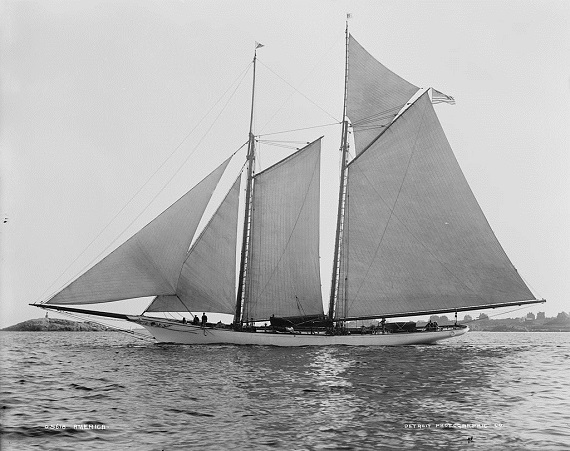One of the oldest and most prestigious sporting events in modern Western Civilization, “The America’s Cup,” is set to begin next year, probably in San Diego. The sailing race has been held by challenge since 1851, the year the schooner America defeated the British (under the eye of Queen Victoria) and took the coveted trophy to New York where it remained until the 1980s.
America was built in New York, but her owners sold the ship after the 1851 race to a British yachtsman and it remained in British hands until 1861. Most sailing enthusiasts—and you won’t find this in the official narrative of the race—don’t know that the famous ship was then sold to the Confederate government in 1861 to serve as a blockade runner. The America thus became the most famous ship to serve in the Confederate Navy, at least at the time.
Her captain, Henry Edward Decie, was treated to lavish parties and high praise in the South. Mary Boykin Chesnut thought enough of him to mention his presence at a family party in May, 1861, just a few weeks after the firing on Fort Sumter. Decie, in fact, had sailed into Savannah with the express purpose of offering his services and his ship to the Confederate government. He was paid handsomely, perhaps $60,000, and Decie has long been described as a flamboyant renegade who operated on self-interest alone. This may be true. He frequently changed his name and his stories, and he may not have been an English subject, yet he had enough capital to buy the ship in 1860 and enough well connected friends to be admitted to two prestigious British yacht clubs. Decie probably needed the money more than he needed the cause in 1861. When he arrived in Savannah, he had a woman in tow and several children, but they were not his, nor is it clear if the woman was his wife. He often called her is mistress. She sailed back to England shortly after Decie struck a deal with Jefferson Davis and Stephen Mallory, the Confederate Secretary of the Navy.
Regardless, the America, perhaps renamed the C.S.S. Memphis, served for a shade over a year running the blockade as a courier. Some have speculated that the Confederacy desired the ship to run James Mason and John Slidell to England, but they were not appointed until several months after the ship was outfitted for service, though as the fastest schooner in the world it would have been perfect for the job. Had Decie and the America been tasked with getting Mason and Slidell to England, the “Trent Affair” may never have taken place.
The ship was scuttled in the St. John’s River near Jacksonville, Florida in 1862 after the Union army took the city. The Union government raised and repaired her, and she served on the opposite end of the blockade for the remainder of the War, chasing down several Confederate blockade runners.
The Confederate Navy was built from scratch and led the Union Navy in wartime innovation (the first ironclad, the first submarine, etc.), but it was the acquisition of a fast schooner that made headlines in the early days of the War. While its glory days were sliding under the horizon like a mariner’s sun in the West, sail still mattered in 1861. It is remarkable that the South attracted men from the Old world to fight for a cause in which they had no native interest, save the preservation of traditional Western Civilization. That was enough. Decie, like Lord Acton and others, saw the Confederacy as the extension of Europe, not the perversion. Like the South, the America exemplified the struggle of tradition against innovation.
I still enjoy yacht races because of the purity and simplicity of sail. There is beauty in the snap of canvas in the wind, the rhythm of the waves slapping the hull, and the solitude of an ocean breeze and blue skies. A sailing ship is to the water as an ox-and-plow is to the farm. Both keep man in touch with the world.







